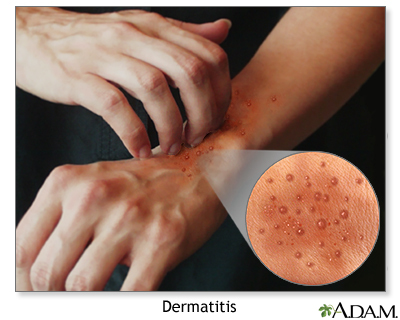Pompholyx eczema
Definition
Pompholyx eczema is a condition in which small blisters develop on the hands and feet. The blisters are often itchy. Pompholyx comes from the Greek word for bubble.
Eczema (atopic dermatitis) is a long-term (chronic) skin disorder that involves scaly and itchy rashes.
Alternative Names
Cheiropompholyx; Pedopompholyx; Dyshidrosis; Dyshidrotic eczema; Acral vesicular dermatitis; Chronic hand dermatitis
Causes
The cause is unknown. The condition seems to appear during certain times of the year.
You are more likely to develop pompholyx eczema when:
- You are under stress
- You have allergies, such as hay fever
- You have dermatitis elsewhere
- Your hands are often in water or moist
- You work with cement or do other work that exposes your hands to chromium, cobalt, or nickel
Women seem to be more prone to developing the condition more than men are.
Symptoms
Small fluid-filled blisters called vesicles appear on the fingers, hands, and feet. They are most common along the edges of the fingers, toes, palms, and soles. These blisters can be very itchy. They also cause scaly patches of skin that flake or get red, cracked, and painful.
Scratching leads to skin changes and skin thickening. Large blisters may cause pain or can get infected.
Exams and Tests
Your doctor may be able to diagnose this condition by looking at your skin.
A skin biopsy may be needed to rule out other causes, such as a fungal infection or psoriasis.
If your doctor thinks the condition may be due to an allergic reaction, allergy testing (patch testing) may be done.
Treatment
Pompholyx may go away on its own. Treatment is aimed at controlling the symptoms, such as itching and preventing blisters. Your doctor will likely recommend self-care measures.
SKIN CARE AT HOME
Keep the skin moist by lubricating or moisturizing the skin. Use ointments (such as petroleum jelly), creams, or lotions.
Moisturizers:
- Should be free of alcohol, scents, dyes, fragrances, or other chemicals.
- Work best when they're applied to skin that is wet or damp. After washing or bathing, pat the skin dry and then apply the moisturizer right away.
- May be used at different times of the day. For the most part, you can apply these substances as often as you need to keep your skin soft.
MEDICINES
Medicines that help relieve itching can be bought without a prescription.
- Take an anti-itch medicine before bed if you scratch in your sleep.
- Some antihistamines cause little or no sleepiness, but aren't so effective for itching. These include fexofenadine (Allegra), loratadine (Claritin, Alavert), cetirizine (Zyrtec).
- Others can make you sleepy, including diphenhydramine (Benadryl).
Your doctor may prescribe topical medicines. These are ointments or creams that are applied to the skin. Types include:
- Corticosteroids, which calm swollen or inflamed skin
- Immunomodulators, applied to the skin, which help keep the immune system from reacting too strongly
- Prescription anti-itch medicines
Follow instructions on how to apply these medicines. Do not apply more than you're supposed to use.
If symptoms are severe, you may need other treatments, such as:
- Corticosteroid pills
- Corticosteroid shots
- Coal tar preparations
- Systemic immunomodulators
- Phototherapy (ultraviolet light therapy)
Outlook (Prognosis)
Pompholyx eczema usually goes away without problems, but symptoms may come back. Severe scratching may lead to thick, irritated skin. This makes the problem harder to treat.
When to Contact a Medical Professional
Contact your health care provider if you have:
- Signs of infection such as tenderness, redness, warmth, or fever
- A rash that does not go away with simple home treatments
Gallery


References
Frey S, Snyder ML, Guttman-Yassky E, Wollenberg A. Hand and foot eczema (endogenous, dyshidrotic eczema, pompholyx). In: Lebwohl MG, Heymann WR, Coulson I, Murrell DF, eds. Treatment of Skin Disease: Comprehensive Therapeutic Strategies. 6th ed. Philadelphia, PA: Elsevier; 2022:chap 99.
James WD, Elston DM, Treat JR, Rosenbach MA, Neuhaus IM. Eczema, atopic dermatitis, and noninfectious immunodeficiency disorders. In: James WD, Elston DM, Treat JR, Rosenbach MA, Neuhaus IM, eds. Andrews' Diseases of the Skin. 13th ed. Philadelphia, PA: Elsevier; 2020:chap 5.